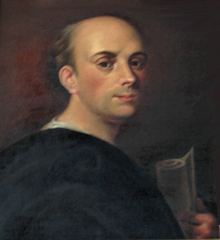
Stanisław II August, known also by his regnal Latin name Stanislaus II Augustus, and as Stanisław August Poniatowski, was King of Poland and Grand Duke of Lithuania from 1764 to 1795, and the last monarch of the Polish–Lithuanian Commonwealth.

Count Jan Klemens Branicki was a Polish nobleman, magnate and Hetman, Field Crown Hetman of the Polish–Lithuanian Commonwealth between 1735 and 1752, and Great Crown Hetman between 1752 and 1771. One of the wealthiest Polish magnates in the 18th century, owner of 12 towns, 257 villages and 17 palaces. He was the last male representative of the Branicki family.

Count Roman Ignacy Potocki, generally known as Ignacy Potocki, was a Polish nobleman, member of the influential magnate Potocki family, owner of Klementowice and Olesin, a politician, writer, and office holder. He was the Marshal of the Permanent Council in 1778–1782, Grand Clerk of Lithuania from 1773, Court Marshal of Lithuania from 1783, Grand Marshal of Lithuania from 16 April 1791 to 1794.

The Great Sejm, also known as the Four-Year Sejm was a Sejm (parliament) of the Polish–Lithuanian Commonwealth that was held in Warsaw between 1788 and 1792. Its principal aim became to restore sovereignty to, and reform, the Commonwealth politically and economically.

Spytek of Melsztyn was a Polish nobleman (szlachcic) of the Leliwa coat of arms.

Mikołaj Bazyli Potocki was a Polish nobleman, starost of Kaniv, Bohuslav, benefactor of the Buchach townhall, Pochayiv Lavra, Dominican Church in Lviv, deputy to Sejm and owner of the Buchach castle.

Franciszek Bohomolec, S.J., Bogoria Coat of Arms, writing pseudonymously as: Daniel Bobinson, Dzisiejkiewicz, F. B., F. B. S. J., Galantecki, J. U. P. Z., Jeden Zakonnik S. J., Jeden Zakonnik Societatis Jesu, Lubożoński, Ludziolubski, M. Z. S. W., Murmiłowski, N. N., N** N***, Ochotnicki, Odziański, Pokutnicki, Pośrzednicki, Poznajewski, Prożniak nie Tęskniący, Staroświat, Śmiałecki, Szkolnicki, Theosebes, Ucziwski, was a Polish Jesuit teacher, writer, poet, satirist, social commentator, linguist, translator, dramatist and theatrical reformer who was one of the principal playwrights of the Polish Enlightenment. After the Suppression of the Society of Jesus, he continued his usual work and in addition became an editor, publisher and printer.

Yazlovets is a village in Chortkiv Raion, Ternopil Oblast, Ukraine. It is a Roman Catholic pilgrimage centre of local significance. The village belongs to the Buchach urban hromada. It lies on the Vilchivchik river, a tributary of the Strypa and is located 16 km south of Buchach and presently has around 600 inhabitants. From 1947-91, it was known as Yablunivka. Apart from the ruined fortifications, there is little sign now that in the 15th and 16th centuries this was a thriving trading centre, on major international mercantile routes between the Black Sea and Northern Europe, and host to multiple merchant families of diverse ethnicities and religions. It was an instance of a privately owned settlement, such as was Zamość in Poland. The city's square has been entirely obliterated.

Lahodiv is a village (selo) in Zolochiv Raion, Lviv Oblast, in western Ukraine. It belongs to Brody urban hromada, one of the hromadas of Ukraine.

The Constitution of 3 May 1791 is an 1891 Romantic oil painting on canvas by the Polish artist Jan Matejko. It is a large piece, and one of Matejko's best known. It memorializes the Polish Constitution of 3 May 1791, a milestone in the history of the Polish–Lithuanian Commonwealth and a high point of the Polish Enlightenment.

The Friends of the Constitution was the first modern Polish political party, formed in May 1791, shortly after the adoption of the Constitution of 3 May 1791, by the efforts of the Patriotic Party. The purpose of the Friends of the Constitution was to defend the reformed political system and to introduce further reforms.

Cassian Sakowicz, also known as Kasjan Sakowicz, was a Polish-Ruthenian (Ukrainian) Orthodox activist and, later, a Catholic theologian, writer, and polemicist.
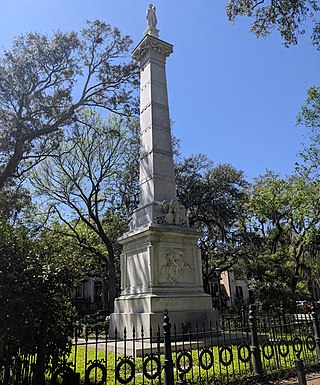
The Casimir Pulaski Monument in Savannah, or Pulaski Monument on Monterey Square, is a 19th-century monument to Casimir Pulaski, in Monterey Square, on Bull Street, Savannah, Georgia, not far from the battlefield where Pulaski lost his life during the siege of Savannah.

Jarosław Saturnin Leitgeber was a Polish writer, bookseller and publisher. His brother, also a book bookseller and publisher, Mieczysław Antoni Leitgeber, inspired his career. Jarosław got his experience by working with his brother, interrupted only by military service in 1869.
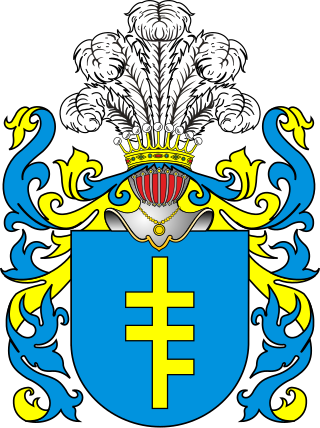
Stefan Aleksander Potocki, was a Polish nobleman, the voivode of Belz. With his second wife Joanna Sieniawska, he founded a UGCC Basilian monastery in Buchach in Lublin, on December 7, 1712. Owner of Buchach Castle.
Janusz Andrzej Rieger is a Polish linguist and slavist specializing in the history of Polish language in Kresy, professor of the humanities, member of the Warsaw Scientific Society. He worked at the Institute of Slavic Studies and at the Institute of Polish Language of the Polish Academy of Sciences, and lectured at the University of Warsaw.
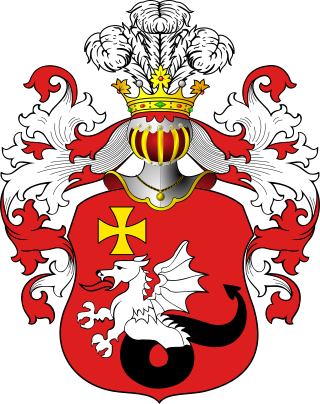
Teodor Lacki – Hussar rotmistrz, Lithuanian field writer, and alchemist.
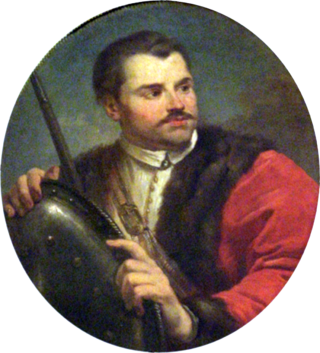
Prince Roman Fedorovich Sanguszko was a soldier and statesman of the Grand Duchy of Lithuania. He served as governor (voivode) of Bracław and was hetman of Lithuania from 1567 until his death. He fought at the Battle of Ula in 1564 and belonged to the nesuhoizhskoy branch of the House of Sanguszko.

Mieczysław Jan Gębarowicz was a Polish art historian, soldier, dissident, museum director and custodian of cultural heritage. He studied history and the history of art at Lwów University During the 1940s and 1950s he was responsible for saving many Polish cultural works in Lviv, including books and manuscripts, from being destroyed or dispersed.

Kostilnyky is a Ukrainian village in the Zolotyi Potik settlement hromada, in the Chortkiv Raion of the Ternopil Oblast. It is located on the Dniester River.
